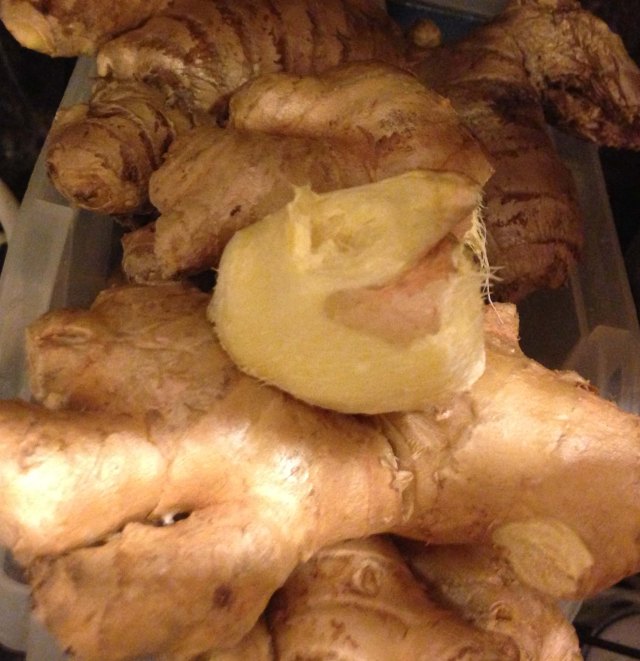Writer’s Note: Back to basics after last week’s lesson on how happiness plays an important role in your daily detoxification. But just to follow up with one more idea. Your track to happiness should include what will bring it long term and that is fulfillment with what you are doing with your life. How do you find fulfillment? Understand why you were put here, know your purpose and then your root for your happiness and fulfillment will be solid. If you would like to follow my occasional commentary along these lines, you can follow personal development blog at http://www.challenyee.com or click on the header.
Back to the diet…
Okay, before I offer you the excerpt from Michael Weiner’s (Savage) “The Antioxident Cookbook.” (1995) on the properties of Ginger, something I commonly do for early onset of a cold, which is a different from Michael’s recommendation below, is to boil down a sliced giant thumb-sized piece of fresh Ginger, going from 2 cups to 1 cup. At the last minute, stir in a tablespoon of brown sugar. If you don’t like adding sugar, you could use honey or maple syrup after the boiling is completed. The sweetness balances the spicy nature of the Ginger taste, making it more palatable, especially for children.
Michael’s description of Ginger also includes some scientific terms, which will be good for you, if you are into the chemical properties.
And now for Mike’s passage on Ginger…
GINGER
Scientific Name: Zingiber officinale
Parts Used: Rhizome
Dosage: Root: 1 ounce of rhizome to 1 pint of water. Boil the water separately then pour over the plant material and steep for 5 to 20 minutes, depending on the desired effect. Drink hot or warm, 1 to 2 cups per day.
Recent Scientific Findings
Currently, Ginger has received new attention as an aid for motion sickness. Ginger tea has long been an herbal remedy for coughs and asthma, related to allergy or inflammation; the creation of the soft drink ginger ale sprang from the common folkloric usage of this herb, and still today remains a popular beverage for the relief of stomach upset. Externally Ginger is a rubefacient, and has been credited in the connection of relieving headache and toothache.
The mechanism by which Ginger produces anti-inflammatory activity is that of the typical NSAID (non-steroidal anti-inflammatory drug). This common spice is a more biologically active prostaglandin inhibitor (via cyclo-oxygenase inhibition) than onion and Garlic.
By slowing associated biochemical pathways an inflammatory reaction is curtailed. In one study Danish women between the ages of 25 to 65 years, consumed either 70 grams raw onion or 5 grams raw ginger daily for a period of one week. The author measured thromboxane production and discovered that ginger, more clearly than onion, reduced thromboxane production by almost 60%. This confirms the Ayurvedic “prescription” for this common spice and its anti-aggregatory effects.
By reducing blood platelet “clumping,” Ginger, Onion and Garlic may reduce our risk of heart attack or stroke. In a series of experiments with rats, scientists from Japan discovered that extracts of Ginger inhibited gastric lesions by up to 97%. The authors conclude that the folkloric usage of Ginger in stomachic preparations were effective owing to the constituents zingiberene, the main terpenoid and 6-gingerol, the pungent principle.
In an earlier look at how some of the active components of Ginger (and onion) act inside our cells, it was found that the oils of these herbs inhibit the fatty acid oxygenases from platelets, thus decreasing the clumping of these blood cell components.
A 1991 double-blind, randomized cross-over trial involved thirty women suffering from hyperemesis gravid arum. Ginger was alternated with a placebo. Seventy percent of the women confirmed they subjectively preferred the period in which they took the Ginger. More objective assessment verified the subjective relief was found after the use of the Ginger reactions, as significantly greater relief was found after the use of the Ginger.
In a series of experiments with rates,scientists from Japan discovered that extracts of ginger inhibited gastric lesions by 97%. The authors concluded that the folkloric usage of Ginger in stomach preparations was effective due to the constituents zingiberene, the main terpenoid, and 6-gingerol, the pungent principle.
***
If you got some value from this, please LIKE COMMENT SHARE

